Rationale of the Week | Giving Up Tortillas?

For our March 16th Question of the Week, over 86% of respondents chose the best answer!
Before we start though, if you don’t want any spoilers and haven’t tried the question yet, you can answer below: Answer Question
Question: PZ arrives for their diabetes appointment with their food diary and glucose log book. PZ’s blood glucose levels have improved since last visit by about 20 points, with morning glucose levels in the 130 range and bedtime glucose in the 180 range. When you ask PZ about what changes they have made, PZ shrugs their shoulders and says, “I quit eating tortillas because my children said they are bad for me.”
What is the best response?
Answer Choices:
- Good for you, giving up tortillas is really hard.
- Your children sound like they are worried about your health?
- Yes, we don’t recommend tortillas since they are high in starch.
- How are you feeling about giving up tortillas?

As shown above, the most common choice was option 4, the second most common answer was option 2, then option 1, and finally option 3.
Getting to the Best Answer
If you are thinking about taking the certification exam, the content of this practice test question will set you up for success. The exam will present questions that require test takers to apply a blend of science coupled with psychosocial awareness to determine the best answer.
Answers & Rationale
Answer 1 is incorrect, 2.31% chose this answer. “Good for you, giving up tortillas is really hard”. We notice that PZ shrugs their shoulders when they tell us they have given up tortillas. In addition, PZ states that they have stopped eating tortillas, not because they think it is best for them to stop, but because their children advised them that tortillas are bad. The word “bad” is loaded with judgment and perhaps PZ is feeling ashamed for eating this traditional food that has been part of their everyday life for decades. For this response, instead of affirming giving up tortillas, a better choice would be to explore this choice further.
Answer 2 is incorrect, 9.49% of you chose this answer. “Your children sound like they are worried about your health?” This seems like an accurate response, but is it the BEST response? The goal of DSME is to provide a person-centered approach. This question puts the emphasis on the children’s belief that tortillas are bad instead of exploring how the person with diabetes is responding to this drastic behavior change.
Answer 3 is incorrect, 1.28% of you chose this answer “Yes, we don’t recommend tortillas since they are high in starch.” One corn tortilla has 15gms of carbohydrate, plus fiber and other micronutrients. Tortillas can absolutely be included as part of a healthy meal plan. In addition, tortillas are more than a serving of starch, they are a central and traditional part of the meal for many cultures.
Answer 4 is correct, 86.92% of you chose this answer. ” How are you feeling about giving up tortillas?” GREAT JOB. Most of you chose this person-centered response which gives us an opportunity to see how giving up tortillas is impacting PZ from an emotional standpoint. As diabetes specialists, we know that eliminating tortillas completely may not be the best choice from an evidence-based and emotional perspective.
We hope you appreciate this week’s rationale! Thank you so much for taking the time to answer our Question of the Week and participate in this fun learning activity!
Sign up for Diabetes Blog Bytes – we post one daily Blog Byte from Monday to Friday. And of course, Tuesday is our Question of the Week. It’s Informative and FREE! Sign up below!
[yikes-mailchimp form=”1″]Accreditation: Diabetes Education Services is an approved provider by the California Board of Registered Nursing, Provider 12640, and Commission on Dietetic Registration (CDR), Provider DI002. Since these programs are approved by the CDR it satisfies the CE requirements for the CDCES regardless of your profession.*
The use of DES products does not guarantee the successful passage of the CDCES exam. CBDCE does not endorse any preparatory or review materials for the CDCES exam, except for those published by CBDCE.
Rationale of the Week | Get Your Calculator Ready!

For our March 9th Question of the Week, over 67% of respondents chose the best answer!
Before we start though, if you don’t want any spoilers and haven’t tried the question yet, you can answer below: Answer Question
Question: JR wants to lose weight in the next 30 days by drinking less juice. There are 100 calories per glass of juice and JR usually drinks 3 glasses a day.
How much weight would JR lose by only drinking 1 glass a day?
Answer Choices:
- 0.85 pounds
- It depends on the type of juice
- 1.7 pounds
- 3000 calories
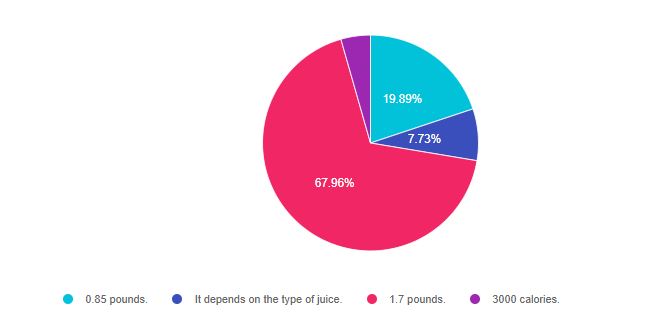
As shown above, the most common choice was option 3, the second most common answer was option 1, then option 2, and finally option 4.
Getting to the Best Answer
If you are thinking about taking the certification exam, the content of this practice test question will set you up for success. The exam will present questions that require test takers to apply their math skills to a word problem and choose the BEST answer. If you see a question that requires math, just take a deep breath, read the question carefully and call upon your abundant common sense. For this particular question, we also need to know that 1 pound equals 3,500 kcals.
Answers & Rationale
Answer 1 is incorrect, 19.89% chose this answer. “0.85 pounds”. This was the juicy answer designed to distract test takers from the best answer. JR was drinking 3 glasses of juice and is reducing their intake by 2 glasses of juice. Their net calorie reduction, therefore, is not one glass a day, but 2 glasses a day. Each glass contains 100 calories, leading to a 30-day calorie deficit of 6,000 calories a month (not 3,000 calories).
Answer 2 is incorrect, 7.73% of you chose this answer. “It depends on the type of juice”. Since we are given the caloric content of the juice, we don’t need to know what kind of juice to get the best answer.
Answer 3 is correct, 67.96% of you chose this answer “1.7 pounds”. Good job. JR was drinking 3 glasses of juice and is reducing their intake by 2 glasses of juice. Each glass contains 100 calories. This leads to a 200 calorie a day deficit, and a 30-day calorie deficit of 6,000 calories. 6,000 calories divided by 3,500 calories (1 pound) equals 1.7 pounds.
Answer 4 is incorrect, 4.42% of you chose this answer. “3,000 calories”. If you go back to the root of the question, it asks the test taker, “How much weight” would JR lose. Weight is expressed in kg or pounds, not calories. By making sure the answers’ unit of measure matches the questions’ unit of measure, test takers can eliminate wrong answers.
Special note: I want to acknowledge that weight and weight loss are complicated. It is so much more than a function of calories consumed or deprived. There are hormones, genetics, set-points, co-conditions, and a whole range of other influencing factors that contribute to weight at any given time. This sample test question does not address these factors since its main focus was providing a word problem with math calculations.
I would encourage you to check out this blog on Diabetes and Diet Culture, which interviews Megrette Fletcher, M.Ed., RD, CDCES, co-founder of The Center for Mindful Eating, co-founder of WN4DC Symposium, and author of five mindful eating books. Megrette is a trailblazer in the field and offers a new approach that values the individual first and encourages us to address our own weight biases.
We hope you appreciate this week’s rationale! Thank you so much for taking the time to answer our Question of the Week and participate in this fun learning activity!
Sign up for Diabetes Blog Bytes – we post one daily Blog Byte from Monday to Friday. And of course, Tuesday is our Question of the Week. It’s Informative and FREE! Sign up below!
[yikes-mailchimp form=”1″]Accreditation: Diabetes Education Services is an approved provider by the California Board of Registered Nursing, Provider 12640, and Commission on Dietetic Registration (CDR), Provider DI002. Since these programs are approved by the CDR it satisfies the CE requirements for the CDCES regardless of your profession.*
The use of DES products does not guarantee the successful passage of the CDCES exam. CBDCE does not endorse any preparatory or review materials for the CDCES exam, except for those published by CBDCE.
Rationale of the Week | Steroids, Sugar Spikes and Management Strategies

For our March 2nd Question of the Week, over 58% of respondents chose the best answer!
Before we start though, if you don’t want any spoilers and haven’t tried the question yet, you can answer below: Answer Question
Question: JR is 53 yrs old with type 2 diabetes, BMI of 24.3 and is recovering from a COVID infection. In addition to metformin, a SGLT-2i and a weekly GLP-1 RA, JR is on daily prednisone. Morning blood glucose levels are in the low 100’s, lunch and dinner blood glucose levels are in the 250-300 range.
Which of the following is the best treatment intervention to get lunch and dinner blood glucose levels to goal?
Answer Choices:
- Initiate a low carb meal plan
- Add NPH or 70/30 insulin in morning
- Start evening basal insulin and gradually increase
- Ask provider to stop or reduce prednisone dose

As shown above, the most common choice was option 2, the second most common answer was option 1, then option 4, and finally option 3.
Getting to the Best Answer
If you are thinking about taking the certification exam, the content of this practice test question will set you up for success. The exam often presents vignettes that compel test takers to determine which option offers the BEST answer based on the action times of different insulins.
Answers & Rationale
Answer 1 is incorrect, 16.77% chose this answer. “Initiate a low carb meal plan “. JR has a BMI that is less than 25, which indicates a healthy weight. In addition, JR is recovering from COVID, so making sure they are eating adequate calories and healthy carbs during this recovery phase is very important. Lastly, the spike in blood glucose between lunch and dinner is an expected response since JR is taking morning prednisone.
AM steroids cause hyperglycemia through lunch and dinner.
Answer 2 is correct, 58.87% of you chose this answer. “Add NPH or 70/30 insulin in morning”. YES! Since morning steroids increase insulin resistance throughout the day, especially around lunch and dinner time, morning NPH insulin works remarkably well. This is because NPH action time peaks within 4-10 hours of injection. Another option is to use 70/30 insulin, which is a combination of 70% NPH (or basal) insulin plus 30% bolus. This insulin used before the first meal of the day, can help prevent lunch and dinner blood sugars from going above target later in the day.
Dosing for NPH or 70/30 depends on several factors, including steroid dose, diabetes type and history, body weight and health status. See our article on Steroids and Sugar Spikes – Management Strategies
Answer 3 is incorrect, 11.94% of you chose this answer “Start evening basal insulin and gradually increase”. When people are on morning steroids, their overnight blood sugars generally trend down. Basal insulin isn’t the best choice for addressing mid day to evening glucose elevations.
Answer 4 is incorrect, 12.42% of you chose this answer. “Ask provider to stop or reduce prednisone dose”. While it is true that stopping the prednisone will improve blood glucose levels, it could also contribute to a worsening health status. One of the most effective treatments for people with a serious COVID infection is steroid therapy to decrease inflammation, especially in the lungs. We approach this situation understanding that the steroid is essential and we can help with glucose management to promote recovery.
Want to learn more about this topic? Join Coach Beverly during the Virtual Conference, where she will be discussing treatment strategies for hyperglycemia secondary to steroids.
We hope you appreciate this week’s rationale! Thank you so much for taking the time to answer our Question of the Week and participate in this fun learning activity!
ADCES Desk Reference + 5th Ed Review Guide Book Bundle
The 5th Edition ADCES Desk Reference & 5th Edition Review Guide Bundle –our most popular AADE Book Bundle for exam preparation!
What is included in the ADCES Book Bundle?
The Art & Science of Diabetes Self-Management Education Desk Reference – 5th Edition
Major Features:
- practical information educators can use with patients to avoid complications and comorbidities
- risks and benefits of CGM and the educator’s role in working with patients who use CGM
- updated info on incorporating the ADA, AADE, and AND joint position statement and algorithm of care into a DSME program
ADECES Review Guide for the Diabetes Care and Education Specialist Exam – 5th Edition
Includes an answer key with rationales for all questions included in the guide!
Major Features:
- 480 + multiple-choice questions
- Strategies for preparing for and taking the exam
3 self-assessment tests that cover three main content sections on the CDCES Exam:
- Assessment of Diabetes and Prediabetes
- Interventions for Diabetes and Prediabetes
- Disease Management
Sign up for Diabetes Blog Bytes – we post one daily Blog Byte from Monday to Friday. And of course, Tuesday is our Question of the Week. It’s Informative and FREE! Sign up below!
[yikes-mailchimp form=”1″]
Accreditation: Diabetes Education Services is an approved provider by the California Board of Registered Nursing, Provider 12640, and Commission on Dietetic Registration (CDR), Provider DI002. Since these programs are approved by the CDR it satisfies the CE requirements for the CDCES regardless of your profession.*
The use of DES products does not guarantee the successful passage of the CDCES exam. CBDCE does not endorse any preparatory or review materials for the CDCES exam, except for those published by CBDCE.
Rationale of the Week | How to work in Birthday Cake?

For our February 23rd Question of the Week, over 94% of respondents chose the best answer!
Before we start though, if you don’t want any spoilers and haven’t tried the question yet, you can answer below: Answer Question
Question: A 59 year old with type 2 diabetes, A1c of 7.2%, takes bolus insulin before meals, plus basal insulin at night and metformin. They ask you how to best work in a piece of birthday cake for their grandchild’s upcoming birthday celebration.
What is the best advice?
Answer Choices:
- Take additional bolus insulin to cover the extra carbs
- Accept the cake but don’t actually eat it
- Increase their nighttime basal insulin to prevent hyperglycemia
- Skip the previous meal to allow for the extra cake carbs
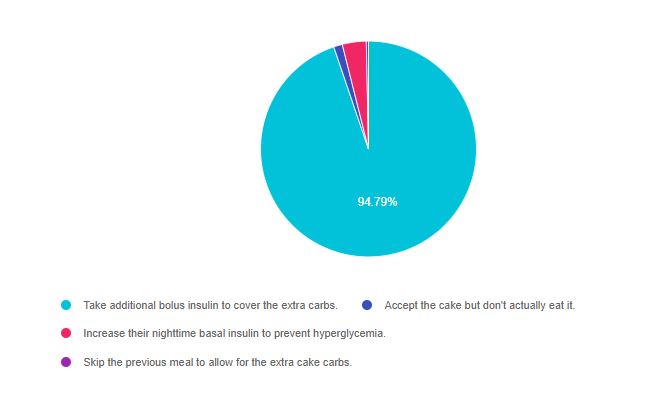
As shown above, the most common choice was option 1, the second most common answer was option 3, then option 2, and finally option 4.
Getting to the Best Answer
If you are thinking about taking the certification exam, the content of this practice test question will set you up for success. The exam often presents vignettes that compel test takers to determine which option incorporates a person centered approach. Person centered choices are usually the BEST answer.
Answers & Rationale

Answer 1 is correct, 94.79% chose this answer. ” Take additional bolus insulin to cover the extra carbs”. Yes, this is the BEST person-centered answer. People with diabetes can choose to increase their bolus insulin to cover for special occasions, like birthday cake.
Answer 2 is incorrect, 1.29% of you chose this answer. “Accept the cake but don’t actually eat it”. Based on this vignette, the person with diabetes wants to “work” the cake into their meal plan. A person centered approach honors their choice and helps them determine how to enjoy the cake while managing blood sugars.
A person centered approach honors their choice and helps them determine how to enjoy the cake while managing blood sugars.
Answer 3 is incorrect, 3.56% of you chose this answer “Increase their nighttime basal insulin to prevent hyperglycemia”. Since basal insulin does not cover carbohydrates or protect against post prandial hyperglycemia, increasing nighttime basal is not the best answer. As a matter of fact, increasing nighttime basal could cause morning hypoglycemia.
Answer 4 is incorrect, 0.36% of you chose this answer. “Skip the previous meal to allow for the extra cake carbs”. This action could lead to hypoglycemia since this person is on basal bolus insulin. For this reason, it is not the best answer.
We hope you appreciate this week’s rationale! Thank you so much for taking the time to answer our Question of the Week and participate in this fun learning activity!
[yikes-mailchimp form=”1″]
Accreditation: Diabetes Education Services is an approved provider by the California Board of Registered Nursing, Provider 12640, and Commission on Dietetic Registration (CDR), Provider DI002. Since these programs are approved by the CDR it satisfies the CE requirements for the CDCES regardless of your profession.*
The use of DES products does not guarantee the successful passage of the CDCES exam. CBDCE does not endorse any preparatory or review materials for the CDCES exam, except for those published by CBDCE.
Rationale of the Week | Best Fix for Hyperglycemic Spike?

For our February 16th Question of the Week, over 76% of respondents chose the best answer!
Before we start though, if you don’t want any spoilers and haven’t tried the question yet, you can answer below: Answer Question
Question: LS is 79 years old and their most recent A1c is 7.4%. LS takes metformin 1000 mg twice daily and sitagliptin (Januvia) plus 14 units of basaglar at before sleep at 2am. LS is excited that they started using a Freestyle Libre sensor and shows you the glucose trends. You notice that glucose levels rise to 250 – 350 in between noon to 4pm.
What is the next best action?
Answer Choices:
- Start bolus insulin at breakfast
- Increase basal insulin by 20%
- Add a low dose sulfonylurea
- Assess food timing and content
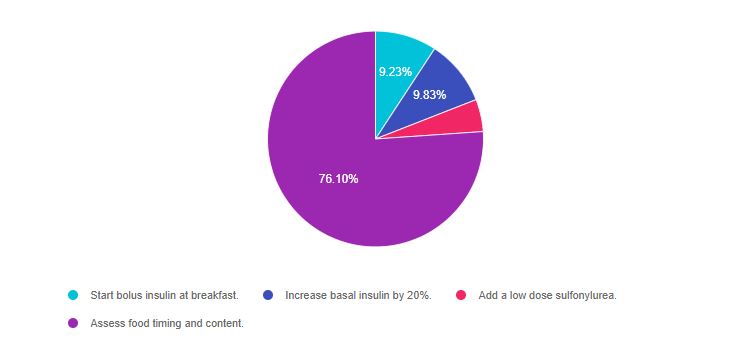
As shown above, the most common choice was option 4, the second most common answer was option 2, then option 1, and finally option 3.
Getting to the Best Answer
If you are thinking about taking the certification exam, the content of this practice test question will set you up for success. The exam often present vignettes that compel test takers to weed through the details and figure out the key intent of the question and chose the BEST answer.
Answers & Rationale
Answer 1 is incorrect, 9.23% chose this answer. “Start bolus insulin at breakfast”. Giving bolus insulin at breakfast would not prevent the glucose elevations from 12pm to 4pm. If we were to start bolus insulin to help with these afternoon spikes, we would need to give it before lunch to match post lunch glucose elevations.
Answer 2 is incorrect, 9.83% of you chose this answer. “Increase basal insulin by 20%”. Basal insulin helps to manage overnight and between-meal blood glucose levels. It is not effective at preventing post-prandial hyperglycemia. We evaluate if a person is taking enough basal insulin by seeing if fasting blood glucose is in the 80-130 mg/dl range.
Answer 3 is incorrect, 4.84% of you chose this answer “Add a low dose sulfonylurea”. Generally speaking, if a person is on basal insulin we are reluctant to add a sulfonylurea, since it can potentiate hypoglycemia (LS’s A1c is 7.4%) and may not address this specific issue of lunch time post-prandial spike. In addition, since the A1c is so close to target, it might be a good idea to take a closer look at food intake and activity and it’s impact on post lunch blood sugars.
Answer 4 is correct, 76.10% of you chose this answer. “Assess food timing and content”. GREAT JOB team. Most of you chose the best answer. As it turns out, LS was eating cereal and “mini” bagels for lunch. This explained the post meal spike. By helping LS understand which foods are carbohydrates and their impact on blood glucose, LS was eager to make adjustments at lunch to get blood sugar to target.
We hope you appreciate this week’s rationale! Thank you so much for taking the time to answer our Question of the Week and participate in this fun learning activity!
Test Taking Practice Exam Toolkit Webinar
20 Sample Practice Questions

You are invited to join Coach Beverly for this FREE Webinar. And, if you want to have access to an additional 220+ sample practice online questions, you can purchase the complete Test Taking Toolkit.
For many of us, taking the certification exam is a nerve-wracking process.
During this webinar, Coach Beverly will help you transform your nervousness into focused energy that will help you succeed. She will provide test-taking tips based on her experience taking the certification exam six times.
To provide plenty of practice, Coach Beverly will sample 20 test questions that have been plucked from our Test Taking Toolkit during this free webinar.
She will explain how to dissect the question, eliminate wrong answers and avoid getting lured in by juicy answers.
2 Ways to Join Test Taking Webinar
Purchase for $49
This includes access to the recorded version of this webinar on your Online University Student Portal.
Plus, the Test Taking Toolkit provides you over 220 sample online practice questions, simulating the exam experience. A perfect way to assess your knowledge and create a focused study plan, while increasing your test-taking confidence.
Watch Webinar for FREE
This includes a review of 20 sample test questions with test-taking strategies. This does not include access to the recorded webinar or the practice questions.
Sign up for Diabetes Blog Bytes – we post one daily Blog Byte from Monday to Friday. And of course, Tuesday is our Question of the Week. It’s Informative and FREE! Sign up below!
[yikes-mailchimp form=”1″]
Accreditation: Diabetes Education Services is an approved provider by the California Board of Registered Nursing, Provider 12640, and Commission on Dietetic Registration (CDR), Provider DI002. Since these programs are approved by the CDR it satisfies the CE requirements for the CDCES regardless of your profession.*
The use of DES products does not guarantee the successful passage of the CDCES exam. CBDCE does not endorse any preparatory or review materials for the CDCES exam, except for those published by CBDCE.
Rationale of the Week | When to Stop IV insulin with DKA

For our February 9th Question of the Week, over 50% of respondents chose the best answer!
Before we start though, if you don’t want any spoilers and haven’t tried the question yet, you can answer below: Answer Question
Question: RT is a 49-year-old with type 1 diabetes, admitted to a local hospital to treat Diabetes Ketoacidosis (DKA). RT is on an insulin drip, fluids and potassium replacement therapy and is getting hungry. The IV insulin is running at 2 units an hour and the RTs usual insulin dose at home is 12 units glargine at bedtime and 3-4 units of lispro before meals.
Before stopping the IV insulin, what is the most important action?
Answer Choices:
- Maintenance of glucose less than 200 for at least 4 hours
- Give 3 units of bolus insulin via IV and at least 6 units of glargine
- Evaluate labs to make sure that RT is ketone negative
- Determine if potassium replacement is still needed

As shown above, the most common choice was option 3, the second most common answer was option 1, then option 2, and finally option 4.
Getting to the Best Answer
If you are thinking about taking the certification exam, the content of this practice test question will set you up for success. There are questions on in-hospital care of diabetes and treating hyperglycemic crises.
DKA Quick Review
Before we answer this question, we thought we would provide a quick summary of the basics of DKA.
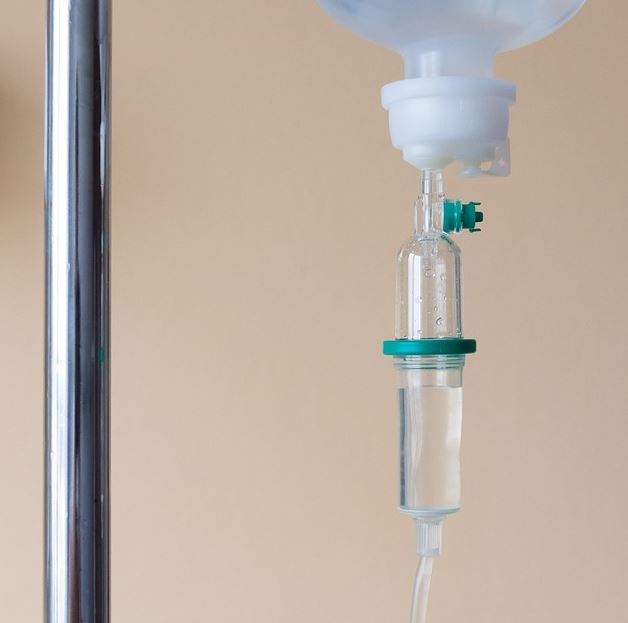
Diabetes Ketoacidosis occurs because there is not enough insulin to use glucose for fuel. The body turns to fat for fuel and this causes a build-up of ketone bodies in the blood and urine. Since ketone bodies are acids, they lower the pH of the blood potentially causing a life-threatening acidosis.
Insulin therapy is required to stop acidosis.
Additionally, even if the glucose is under 200, the person can still be “under insulinized” and ketotic. That is why the insulin drip can only be stopped when the person is ketone negative and no longer burning fat for fuel. One sign that they are moving out of ketosis is that they become hungry. Ketone bodies are very irritating to the GI system and cause nausea and sometimes significant abdominal pain.
If the insulin drip is stopped too early, when the person is still positive for ketones, they are at risk of going back into DKA.
Potassium – When people are experiencing ketosis they are insulin deprived. This lack of insulin allows potassium to leave the cells and enter the bloodstream. Much of this excessive extracellular potassium is then renally excreted. When insulin therapy is started, this pushes potassium back into the cells and can cause a dangerous drop in serum potassium levels. For this reason, most people with DKA will need potassium replacement.
It is critically important to evaluate potassium before starting insulin therapy in someone with DKA. If the potassium is less than 3.3 mEq/L, the guidelines recommend providing potassium replacement therapy first, then starting insulin when potassium levels are stable.
See our blog Treating DKA with SubQ Insulin here for more details.
Answers & Rationale
Answer 1 is incorrect, 19.34% chose this answer. “Maintenance of glucose less than 200 for at least 4 hours”. Even if the glucose is under 200, the person can still be “under insulinized” and ketotic. That is why the insulin drip can only be stopped when the person is ketone negative and no longer burning fat for fuel.
Answer 2 is incorrect 16.86% of you chose this answer. “Give 3 units of bolus insulin via IV and at least 6 units of glargine”. It is true that subq insulin needs to be administered about 2 hours before stopping the IV insulin since the half-life of IV insulin is only minutes. But, most important is that we need to make sure their acidosis is resolved. If the insulin drip is stopped too early, when the person is still positive for ketones, they are at risk of going back into DKA.
Answer 3 is correct 51.02% of you chose this answer “Evaluate labs to make sure that RT is ketone negative” YES, this is the BEST Answer. If they are ketone negative and blood sugars are under 200, we can inject subq basal insulin about 2 hours before stopping the drip to stabilize glucose levels. Then we provide subq insulin replacement therapy based on prior history and body weight.
Answer 4 is incorrect 12.78% of you chose this answer. “Determine if potassium replacement is still needed” Of course, we are keeping a close eye on potassium, but an IV is not required to administer potassium since it can be given orally. In addition, the most important factor in determining if the IV insulin can be stopped is the state of ketosis.
We hope you appreciate this week’s rationale! Thank you so much for taking the time to answer our Question of the Week and participate in this fun learning activity!
Hyperglycemic Crises, DKA & HHS | 1.0 CEs
Join Coach Beverly to learn more about the causes and treatment of hyperglycemic crisis.

This course is included in: Level 2 – Standards of Care. Purchase this course individually for $19 or the entire bundle and save 70%.
This 60-minute course discusses common causes of hyperglycemia crises. Topics include hyperglycemia secondary to medications and insulin deprivation. The difference and similarities between Diabetes Ketoacidosis and Hyperosmolar Hyperglycemic Syndrome are also covered. Treatment strategies for all situations are included.
Topics include:
- Common causes of hyperglycemic crises.
- The difference and similarities between DKA and HHS and treatment strategies
- Causes and treatment of hyperglycemic crises.
Sign up for Diabetes Blog Bytes – we post one daily Blog Byte from Monday to Friday. And of course, Tuesday is our Question of the Week. It’s Informative and FREE! Sign up below!
[yikes-mailchimp form=”1″]
Accreditation: Diabetes Education Services is an approved provider by the California Board of Registered Nursing, Provider 12640, and Commission on Dietetic Registration (CDR), Provider DI002. Since these programs are approved by the CDR it satisfies the CE requirements for the CDCES regardless of your profession.*
The use of DES products does not guarantee the successful passage of the CDCES exam. CBDCE does not endorse any preparatory or review materials for the CDCES exam, except for those published by CBDCE.
Rationale of the Week | Which Vaccines Does JL Need?

For our February 2nd Question of the Week, over 75% of respondents chose the best answer!
Before we start though, if you don’t want any spoilers and haven’t tried the question yet, you can answer below: Answer Question
Question: JL is 65 years old and has diabetes. JL tells you they had two different pneumonia vaccines in the past, but they are wondering what vaccinations they need this year.
What is the BEST answer?
Answer Choices:
- Flu and Pneumonia PPSV23 [Pneumovax]
- Hepatitis B and Flu vaccine
- Pneumonia PCV13 [Prevnar] and Human Papilloma Virus (HPV)
- Zoster and Hepatitis B vaccine

As shown above, the most common choice was option 1, the second most common answer was option 2, then option 4, and finally option 3.
Getting to the Best Answer
If you are thinking about taking the certification exam, the content of this practice test question will set you up for success. We have posted Vaccination Slides below from our Annual Standards of Care 2021 Webinar update.
Answer 1 is correct 75.38% chose this answer. “Flu and Pneumonia PPSV23 [Pneumovax]” The 2021 ADA Standards provide much clearer guidelines on vaccinations. People with diabetes need a flu vaccine yearly and a pneumonia vaccine, PPSV23, after they turned 65 regardless of previous pneumonia vaccine history.
Answer 2 is incorrect 15.04% of you chose this answer. “Hepatitis B and Flu vaccine.” The flu vaccine is correct. For people aged 65 or older, the hepatitis vaccine is only administered if the person is at increased risk of hepatitis and is based on a cost-benefit discussion with their provider.
Answer 3 is incorrect 2.05% of you chose this answer “Pneumonia PCV13 [Prevnar] and Human Papilloma Virus (HPV) vaccine” The ADA no longer recommends that people 65 years and older routinely receive the PCV13 vaccine. The HPV vaccine is recommended for people up to the age of 27 and if indicated up to the age of 45.
Answer 4 is incorrect 7.52% of you chose this answer. “Zoster and Hepatitis B vaccine” Zoster vaccine is recommended for people over the age of 50 with diabetes. However, for people aged 65 or older, the hepatitis vaccine is only administered if the person is at increased risk of hepatitis and is based on a cost-benefit discussion with their provider.
We hope you appreciate this week’s rationale! Thank you so much for taking the time to answer our Question of the Week and participate in this fun learning activity!
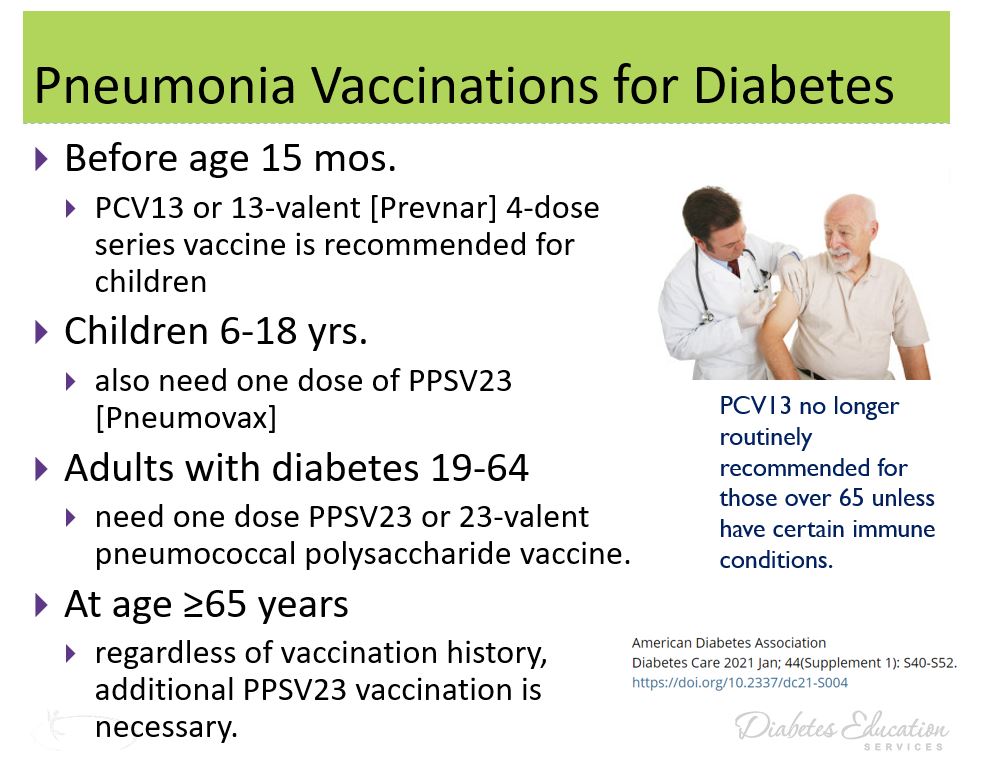

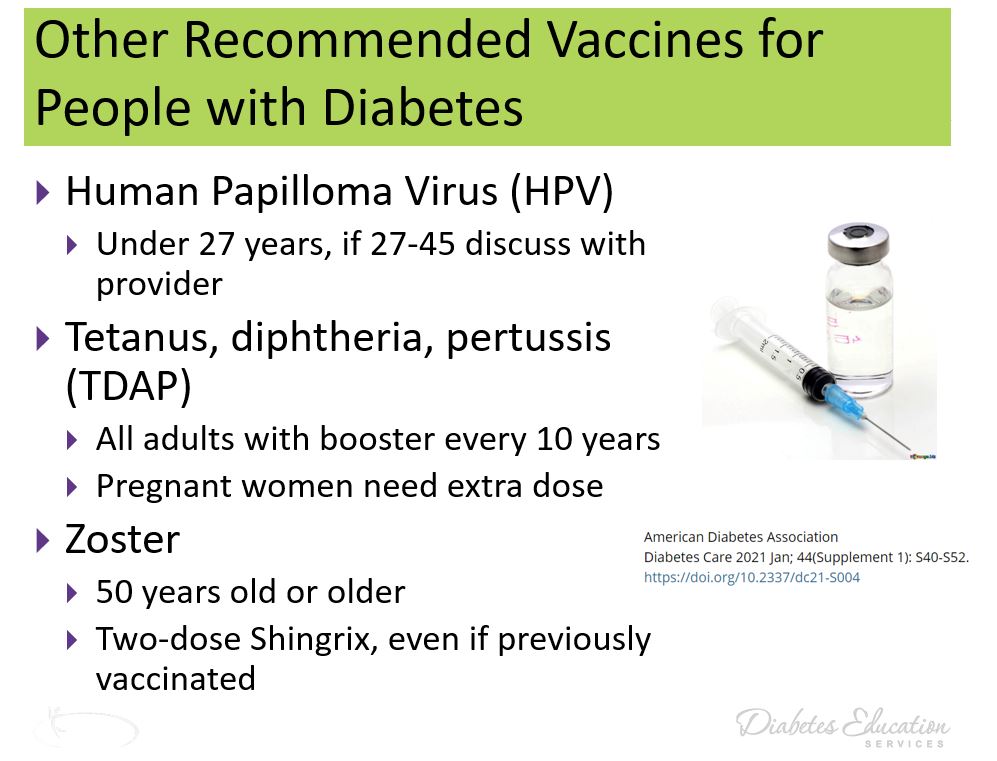
Sign up for Diabetes Blog Bytes – we post one daily Blog Byte from Monday to Friday. And of course, Tuesday is our Question of the Week. It’s Informative and FREE! Sign up below!
[yikes-mailchimp form=”1″]Accreditation: Diabetes Education Services is an approved provider by the California Board of Registered Nursing, Provider 12640, and Commission on Dietetic Registration (CDR), Provider DI002. Since these programs are approved by the CDR it satisfies the CE requirements for the CDCES regardless of your profession.*
The use of DES products does not guarantee the successful passage of the CDCES exam. CBDCE does not endorse any preparatory or review materials for the CDCES exam, except for those published by CBDCE.
Rationale of the Week | What is the B/P Goal?

For our January 26th Question of the Week, over 70% of respondents chose the best answer!
Before we start though, if you don’t want any spoilers and haven’t tried the question yet, you can answer below: Answer Question
Question: RJ is 52 with type 1 diabetes and a minor stroke last year. RJ takes an ACE Inhibitor, insulin, and a statin.
According to ADA Standards of Care 2021, what is the blood pressure target for RJ?
Answer Choices:
- 120/70
- 130/80
- 140/90
- 135/85
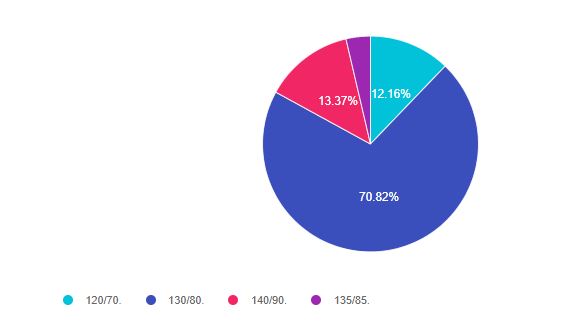
As shown above, the most common choice was option 2, the second most common answer was option 3, then option 1, and finally option 4.
Getting to the Best Answer
If you are thinking about taking the certification exam, the content of this practice test question will set you up for success.
Answer 1 is incorrect 12.16% chose this answer. “120/70”. The ADA Standards suggest that we provide information on healthy eating and the importance of activity, coupled with a referral to a RD and DSMES, when blood pressure levels are greater than 120/70. But, this is not the blood pressure management goal.
Answer 2 is correct 70.82% of you chose this answer. “130/80”. This is the best answer. Since RJ had a stroke, they walk through the door with an existing CV event, which identifies them as higher risk for a future event. The standards state that if the person has experienced a CV event or has a 10 year risk of 15% or greater (using the ASCVD Risk Calculator), the blood pressure target is 130/80.
Answer 3 is incorrect 13.37% of you chose this answer “140/90” The ADA Standards state that the blood pressure target is 140/90 if the 10 year risk of a CV event is less than 15% or the person has not experienced a previous CV event. Since RJ had experienced a minor stroke, the target is 130/80. Of course, this goal is individualized based on individual factors and a risk/benefit analysis.
Answer 4 is incorrect 3.65% of you chose this answer. “135/85” The standards state that if the person has experienced a CV event or has a 10 year risk of 15% or greater (using the ASCVD Risk Calculator), the blood pressure target is 130/80.

We hope you appreciate this week’s rationale! Thank you so much for taking the time to answer our Question of the Week and participate in this fun learning activity!
Sign up for Diabetes Blog Bytes – we post one daily Blog Byte from Monday to Friday. And of course, Tuesday is our Question of the Week. It’s Informative and FREE! Sign up below!
[yikes-mailchimp form=”1″]Accreditation: Diabetes Education Services is an approved provider by the California Board of Registered Nursing, Provider 12640, and Commission on Dietetic Registration (CDR), Provider DI002. Since these programs are approved by the CDR it satisfies the CE requirements for the CDCES regardless of your profession.*
The use of DES products does not guarantee the successful passage of the CDCES exam. CBDCE does not endorse any preparatory or review materials for the CDCES exam, except for those published by CBDCE.








